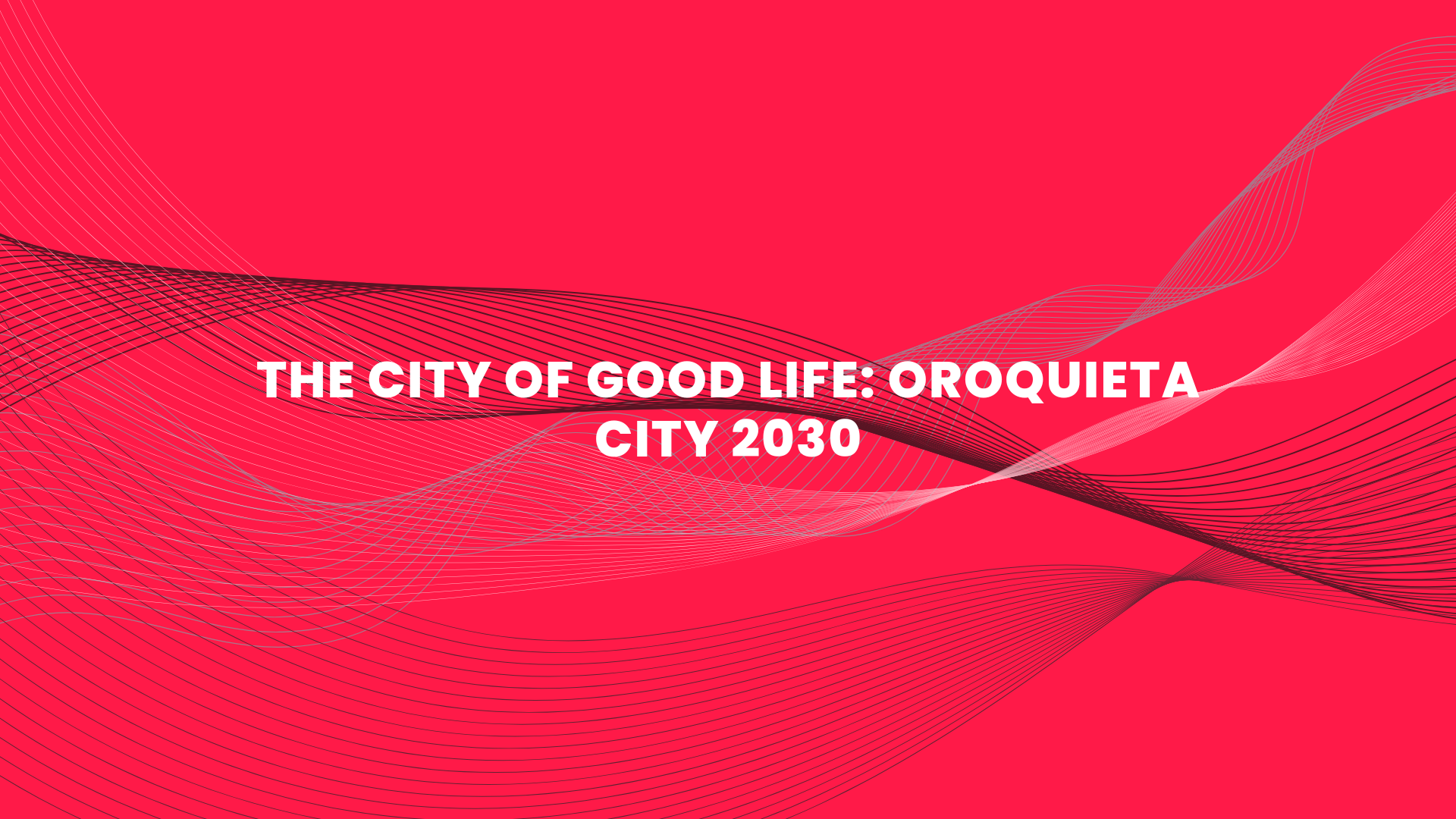
The City Of Good Life: Oroquieta City 2030

What will the city of Oroquieta be like in the year 2030? What are the people’s hopes and fears? Are there alternatives to a business as usual future? What is the city’s preferred future? What is the city’s transformed future? Which future do they wish to become a reality? What steps can the city take to trigger emerging alternatives and create a transformed future for the city and its people? Is the city moving in the right direction?
Are existing platforms, policies, programs and framework flexible, adaptive? Is the economy responsive to local demands and needs? What are the drivers and factors that might influence the city’s future? How can we engage the youth to participate in the creation of alternative and transformed future?
Can it re-envision the Good Life? Is it authentic? Transformative? Meaningful? What are the indicators of a Good Life for Oroquieta City? What type of values and leadership models could kick start and sustain the vision of a Good Life? How can we legitimize the Good Life? Are there existing socio-economic-political models, best practice and local experiences that could support, expand or extend the concept of the Good Life?
These are some of the interesting and provocative questions that emerged in the 3day Futures Literacy and PROUT workshop attended by the local government officials of Oroquieta City.
Futures Thinking and PROUT Workshop
Facilitated by Shermon Cruz, Director Center for Engaged Foresight and Dada Dharmavedananda, PROUT Maharlika and monk of Ananda Marga, the City of Oroquieta organized an introductory futures thinking, strategy development and PROUT workshop to explore alternative futures for the city. The workshop and applied a variety of techniques/methodologies in PROUT and Strategic Foresight to identify potential drivers and influencers that may shape the city’s alternative and transformed futures.
Shermon Cruz gave a briefer on Futures Thinking and Strategy Development and facilitated foundational futures workshop to map, anticipate, question and imagine possible, probable and plausible city futures. Dada Dharmavedananda linked the participants output by questioning the alternatives and to address specific sectoral issues that may disrupt and transform Oroquieta’s future.
Videos on Futures Thinking and PROUT were shared to the participants to inform and deepen the context of the 3 day workshop.
Futures Literacy, Futures Thinking and Strategy Development
According to the OECD (2016), Futures Thinking and Strategy Development is an emerging policy and governance applied by global governance institutions, public and private institutions, the academia, non-government and people organizations, social movements among others to map, anticipate and create alternative and preferred futures. Futures tools and workshops aims to stimulate strategic dialogue, widen understanding of possibilities, strengthens leadership and informed decision-making.
Futures Thinking in public policy and governance uses a multidisciplinary approach to pierce the veil of received opinion and identify the dynamics that are creating the future. A variety of methods – qualitative, quantitative, normative, and exploratory – can help governments illuminate the possibilities, outline policy choices, and assess the alternatives (OECD, 2016).
Futures Triangle on the other hand is a tool invented by Sohail Inatullah to to map three narratives of time – the past, present and future in context.
The PUSHED OF THE PRESENT: quantitative drivers and trends; THE WEIGHT OF HISTORY: challenges, issues, barriers and narratives prohibiting and/or restricting preferred futures and PULLS OF THE FUTURE, these are the compelling images and preferred futures (Inayatullah, 2010) .
CAUSAL LAYERED ANALYSIS (CLA)
“CLA is a technique used in strategic planning and futures studies to more effectively shape the future. Causal layered analysis works by identifying many different levels, and attempting to make synchronized changes at all levels to create a coherent new future.” (https://en.wikipedia.org/wiki/Causal_layered_analysis)
Inayatullah’s original paper as well as his TEDx talk[4] identifies four levels of reality: The litany: This includes quantitative trends, often exaggerated and used for political purposes. The result could be a feeling of apathy, helplessness, or projected action. Social causes, including economic, cultural, political, and historical factors. Wordlview/Discourse: Structure and the discourse that legitimizes and supports the structure. Metaphor and myth are the emotive and unconscious dimensions of the issue. The deepest layer looks at the foundational myths, metaphors and archetypes that influence the unconscious and/or emotional undertone beneath the issues.
After understanding the layered causes of an issue, the method suggests looking at alternatives – either within each layer or beginning with a new myth/metaphor and working up through the layers to create an alternative scenario. From this alternate scenario, new possibilities can be distilled and translated into solutions, policies, and other types of actions that one can begin implementing in the present. (Source: https://libarynth.org/futurist_fieldguide/causal_layered_analysis)


Futures Workshop Output
Participants mapped the pulls, pushes and weights of the city’s future. These drivers could well influence the Oroquieta’s future:
- Transport (public and private)
- Traffic and Congestion
- Investment (local and global)
- Poverty
- Unemployment
- Sports, Health and Wellness
- Climate Change Risk and Disaster Management
- Digitization and automation of the City’s business processes
- Inadequate Resources (financial and non-financial)
- Land Use Plan
- Culture and traditions
- Life expectancy
- In-migration
- Integrity and Branding
- Grants and Aids
- Conflicting values and priorities
The pulls, pushes and weights could reframe, redefine the context of city’s plausible future: The City of Good Life.

Deepening the discussion, Shermon Cruz asked some provocative questions to participants to facilitate the reframing process: What is the city’s definition of good life? What does it mean to experience or to have a good life in Oroquieta? What are the indicators of a good life, at the personal, organizational, city, societal levels, in Oroquieta? What are its success indicators? Is Oroquieta’s version of the Good Life authentic? Transformative? Unique? Responsive to local context, development, growth , values and culture? Using INSPECT method, what are our good life indicators and/or innovation in ideas, nature, social, political, economy, culture and technology? How do we integrate the good life in Oroquieta’s programs, policies, events and activities? How do we storify the good life (health and wealth? Well-being? Work-Life balance? Preventive health care? Employment?)? What’s the narrative of good life for Oroquieta in the now and the future – City of Good Life 2030?
Causal Layered Analysis
Issue #1: 37% Poverty Incidence (2017) Issue #2: 20% Unemployment Rate (2017)
The Causal Layered Analyis gave the participants the space to deconstruct two interlinked sectoral challenges that may prohibit Oroquieta’s vision of the good life: poverty and unemployment.
Using CLA, participants deconstructed and reconstructed poverty and unemployment in Oroquieta 2023. Causal layered analysis works by identifying many different levels, and attempting to make synchronized changes at all levels to create a coherent new future.
Below are the workshops CLA output.

City of Good Life: Negotiation as a Way Forward
The Sarkar Game is used to help individuals and organisations better understand macrohistory and the structured shape of the future(s) as well as to audit the leadership style of their own organisations or institutions (Inayatullah, 2013). Participants were divided into four social groups namely the laborers/workers, warriors, intellectuals and merchants/capitalist class. The game was facilitated by Shermon Cruz. Groups were given a script, tools and were asked to play their role according to the script.
In this game, the workers with the help the intellectuals emerged as winners given that they were able to establish and legitimize the call for fair wages. The merchants failed to bribe their way in as they failed to influence the intellectuals and warriors to threaten and/or shoot the workers. Merchants would give in to the workers’ demands when intellectuals acknowledged worker rights for fair wages and the military to keep the peace. All of the groups were willing to negotiate to keep the peace, the vision alive and achieve justice for all.

